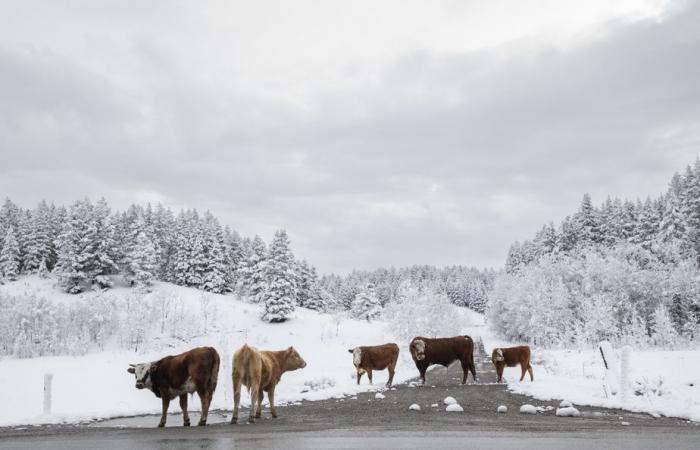(Banff, Alberta) The loggers have been there. Crossing a thick forest, a strip of land a kilometer and a half long on the mountainside has been razed. Only a few scattered snags still stand in this open space of 33 hectares. A thin white shroud follows the shape of the tire tracks left by forestry machinery.
Posted at 1:32 a.m.
Updated at 9:00 a.m.
Norimitsu Onishi
The New York Times
The sound of chainsaws is commonplace in a commercial forest. But here we are in Banff, in Canada’s most famous national park. Clearcutting was once unimaginable in this verdant jewel of the Rockies, where the practice has always been to nip every fire in the bud and preserve every tree.
Stop the fires
But since the fires of recent years, Banff managers have called on foresters to create firebreaks, that is to say buffer zones supposed to prevent forest fires from spreading in the park and reaching the neighboring towns.
PHOTO AMBER BRACKEN, THE NEW YORK TIMES
David Tavernini, fire and vegetation expert at Parks Canada, in a firebreak
“It gives firefighters options if a very intense forest fire spreads quickly,” explains David Tavernini, fire and vegetation expert at Parks Canada, while treading the soft ground of the cleared forest.
Still reeling from the worst forest fire season in its history, Canada is already facing the return of “zombie fires”, which are resuming after smoldering all winter and forcing thousands of residents to flee cities and towns. villages in the West.
18.5 million hectares burned
Coming out of the mildest winter recorded in Canada, populations living near forests are preparing for a new season of forest fires, which have become more frequent and more violent with climate change.
Long-planned fire measures – such as the Banff Park firewall in Alberta, and other projects in Banff itself – have taken on a new urgency.
In 2023, fire has destroyed 18.5 million hectares of forest in Canada – more than double the record set 20 years ago. The smoke reached as far as Europe. The flames spread uncontrolled across the country, not only in the West, but also in Quebec and the Maritimes, where fires of this magnitude are rare.
Already this spring, drought is hitting Alberta. In the Rockies, there was exceptionally little snow, says hydrologist John Pomeroy, who lives near Banff and is director of the Global Water Futures program.
“Conditions this early in the year seem worse than last year,” said Mr. Pomeroy. That said, many things can change. In 2023, we also experienced record heat and little rain. »

PHOTO AMBER BRACKEN, THE NEW YORK TIMES
Cattle on the road near Morley, not far from Banff National Park, Alberta, on April 30. Despite spring snowfall in April, the precipitation deficit persists and almost all of Alberta risks being hit by a significant drought, according to Environment Canada.
Michael Flannigan, a fire management expert at Thompson Rivers University in British Columbia, agrees: It is the combined effect of extreme heat and unusual weather that has led to the record fires of 2023: “ Last year was an aberration. The chances of this happening again are slim,” he says.
But Mr. Flannigan notes that wildfire agencies — which previously hired only seasonal staff, many of them students — are starting to employ professionals year-round, as fire season gets underway. elongate.
Zombie fires
In British Columbia, huge “zombie fires” that had smoldered all winter started again after firefighters were unable to contain them this spring, Mr. Flannigan says: “The season ended so late last year that the firefighters did not have time to finish the cleanup. »
In Banff itself, the woodlands around the town were thinned to make them less flammable. According to Fire Chief Russ Geyer, embers thrown by the advancing wall of fire can float in the air for two kilometers, fly over waterways and ignite other blazes.
Banff’s population is 9,000, but swells to 40,000 on some summer weekends. Firefighters must protect residents and visitors.

PHOTO AMBER BRACKEN, THE NEW YORK TIMES
Parks Canada employees in a fire break in Yoho National Park adjacent to Banff, British Columbia
At Banff National Park, created in 1885 (the oldest in Canada), the policy until 1983 was to nip any fire in the bud, instead of opting for a concerted approach to prevent or manage them. .
As a result, the dense forest is today dominated by conifers and extremely flammable.
Old photos before the creation of the park show a greater variety of species and more clearings, explains Mr. Tavernini, the Parks Canada fire expert. In the past, the forest was regularly thinned by fires started by lightning and by prescribed burning carried out by the indigenous people of the region.
In recent years there have been controlled burns in various parks. The 33-hectare firebreak completed last year along a road in Banff Park is visually spectacular and particularly impressive. A second is planned near the famous Lake Louise. Work could begin this year.
Another even larger firebreak was completed last winter in Yoho National Park, which borders Banff, across the provincial border, in British Columbia.
A logging company cut down the trees on the first two sites in exchange for the wood. In addition, Parks Canada received part of the $80,000 from the sale of the lumber obtained from the harvest, says Shelley Tamelin, forest fire risk reduction project manager at Parks Canada.

PHOTO AMBER BRACKEN, THE NEW YORK TIMES
According to Shelley Tamelin, Parks Canada strives to cut down as few trees as possible to create fire breaks to prevent forest fires from spreading.
These cleared strips are defensive lines against the progression of fires. Firefighters can deploy there and attack the flames directly by drawing water from nearby bodies of water.
But clear-cutting in these forests dear to the population is a delicate subject. Those responsible are aware of this.
“We try to choose perimeters where cutting as few trees as possible allows us to create the largest possible clearance,” declared M.me Tamelin.
This article was published in the New York Times.
Read this article in its original version (in English; subscription required)










